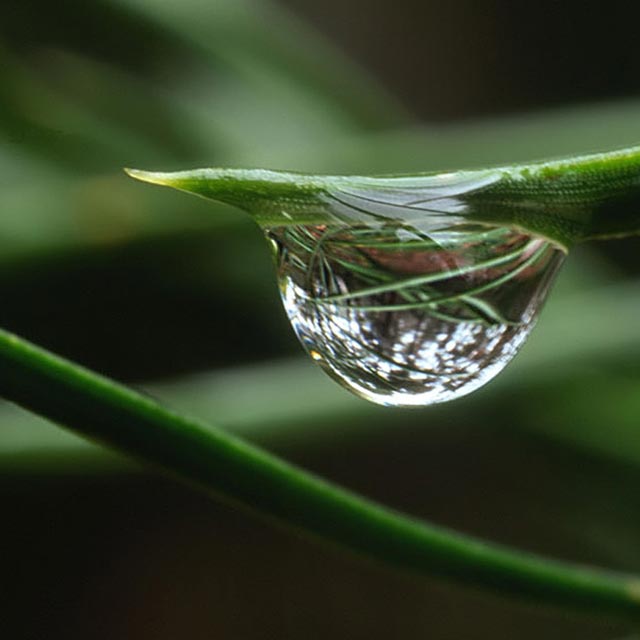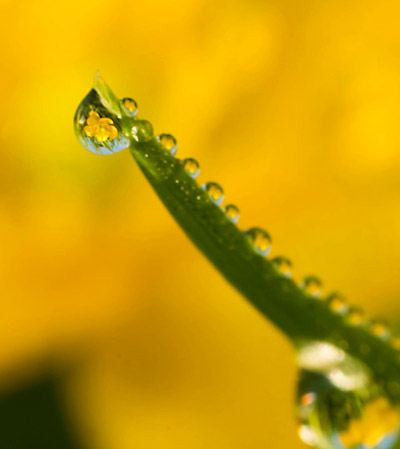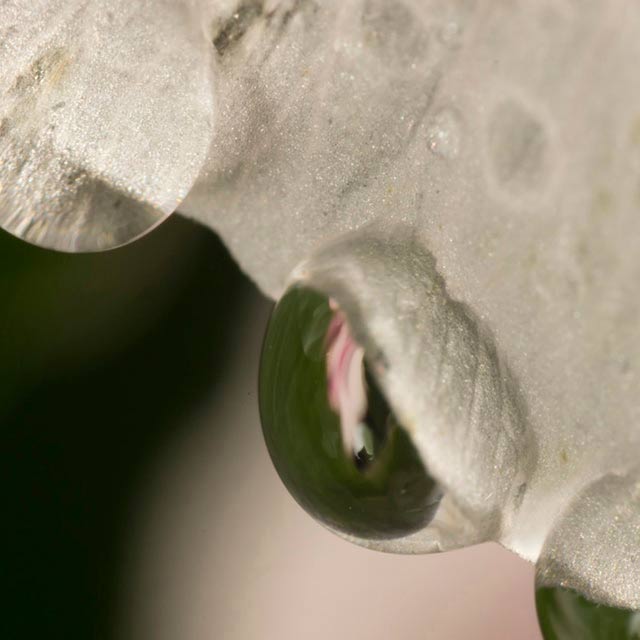
The inside and outside world of water droplets is a fascinating photo subject. When you photograph water droplets ,you can show people an intimate and infinite world of possibilities that is full of beauty. The words I most often hear are: Wow!
Where did you find that? But it’s not just about finding the drops after a rain storm, but it is all about your creative vision and looking at the right time and place. Look closely and you’ll see them for yourselves.
With a little patience, the right equipment and some practice, you will become proficient at creating your own personal vision.
Photograph Water Droplets – Best Subjects
Nature provides wonderful photo subjects, so you are bound to find the perfect water drops on the plants, flowers and other objects after a rain storm or early in the morning after a foggy night.
Look for those drops that are sitting or hanging in just the right position so they contain wonderful reflections of their surroundings or are catching the reflected light. Every drop is unique, so it’s just a matter of finding those drops that spark your creative senses.

Lenses
To achieve a narrow depth of field and complete clarity of the reflection within or around the rain drop, a macro lens is really the best equipment option. If you can’t afford one, you can certainly try some alternative macro equipment methods. I use a 180mm – f/3.5 macro lens with a close-up filter.
With this combination you will not only get really close to tiny water drops but create a wonderful, soft bokeh effect (blurred) in the background.
Tripod & Shutter Release
Always use a tripod and remote or cable shutter release. A sharp image is critical and even the slightest movement of the camera will throw the image out of focus.

Creating the Image
Take your time and of course the obvious – be careful not to bump the plant or object on which the drops sit. Be sure to make multiple photos from a variety of different angles. Each will show the water drops in a new way and you don’t want to miss a great image opportunity. After all, that particular drop will be gone soon.
~ Adjust your tripod and camera so the lens is at the same focal plane as the drop (at the same level).
~ Set your lens on manual focus.
~ Set your camera on Aperture Priority. To get as much of the reflection or areas you choose in focus, you could be using f/8 all the way up to f/22. Make a variety of images at different aperture settings so you have the option of choosing which you like the most.
~ Look through the viewfinder of your camera and select your composition and focal point in or around the water droplet.
~ If your camera allows, switch to Live View, magnify the view on your LCD screen (check your camera manual for instructions) and now focus on the exact desired point within the composition. This provides for better accuracy and clarity. Try different focal points and see the differences in each image.
Tip: when you want to photograph water droplets, wind or even a slight breeze can be a detriment, so you may need to switch to Shutter Priority.

Composition
As with any photography, composition plays an important role when creating the look of the image. Here you’ll want a background with nice colors and light and one that does not distract the viewer away from the main subject.
When one makes photos of rain drops that are 5 mm or less in size, you are stepping into a whole new world. Each mm change in camera position will give you a totally different compositional perspective, so explore all the possibilities. You can choose to create clear reflections or even abstracts within the water drop or focus on the incredible light that bounces off each drop.
Tip: You can use an external flash to get bright photos and nice colors, but be careful here, so you’re not getting too much light reflection from the flash light.
Good luck with your plans to photograph water droplets and have fun creating your own rain drop photos.
by Edwin Brosens
All text & photos: © 2013 Edwin Brosens. All rights reserved.
Images created with Sony Alpha 33 + Sigma 180/3.5 Apo Macro + Canon close-up 500D + Flash

Leave a Reply